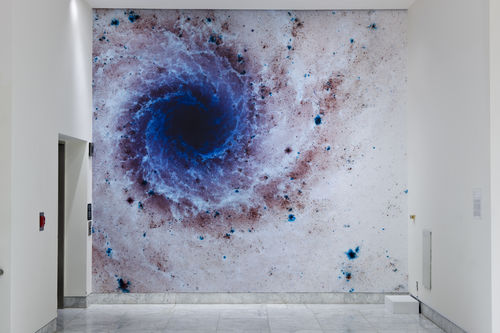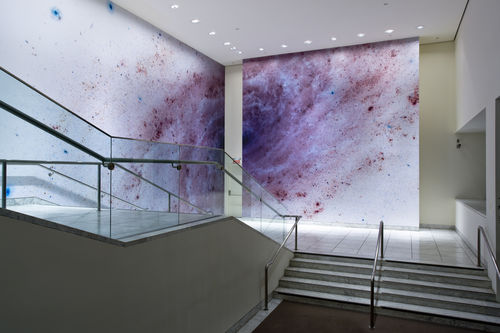
Hammer Projects: Mungo Thomson
- – This is a past exhibition
Los Angeles-based artist Mungo Thomson’s works ponder notions of mysticism and the big questions in life with an underlying deadpan wit. For the Hammer’s Lobby Wall, Thomson presents a variation of his Negative Space project, which as he puts it, “came out of reflecting on the color of nothing; in outer space the void is black, and in the art context the void—the empty gallery—is always white.” Thomson found an online image archive of starscape photos taken by the Hubble Space Telescope and he’s been downloading the copyright-free images and inverting them with a simple Photoshop tool. The result is a spectacular starburst that looks more like a close-up of minerals or marble than space debris. For the Lobby Wall, Thomson has chosen the M74 and NGC 3370 galaxies.
Organized by Hammer curator Ali Subotnick.

Biography
Mungo Thomson was born in 1969 in Woodland, California, and lives in Los Angeles and Berlin. He attended the Whitney Museum Independent Study Program in 1994, and received an MFA from the University of California, Los Angeles, in 2000. His work has been featured in solo exhibitions at Margo Leavin Gallery, Los Angeles; John Connelly Presents, New York; the Kadist Art Foundation, Paris; GAMeC, Bergamo, Italy; and the Fabric Workshop and Museum, Philadelphia (forthcoming). Recent group exhibitions include those at the Hirshhorn Museum and Sculpture Garden, Washington, D.C.; Vancouver Art Gallery; and the Museum of Contemporary Art, Chicago. Thomson’s work has also been shown in several biennial exhibitions, including the 2008 Whitney Biennial in New York; the 2008 Le Havre Biennale in Le Havre, France; and the 2004 California Biennial at the Orange Country Museum of Art, Newport Beach. Writings on his work have appeared in publications such as Artforum, Frieze, Flash Art, and Uovo.
Essay
By Suzanne Hudson
Writing on the work of his friend and fellow Angeleno, painter Laura Owens, Mungo Thomson identified certain traits that broadly distinguish art made in this city: “It tends to be conversational and suggestive and to wear its doubts outright. It displays a certain nihilistic utopianism and is comfortable with oxymorons. It’s not the kitsch and fiberglass of a dystopic Disneyland, but the spaced-out rigor of spending a day in the garden.”1 Reading this recently, I could not help but think that—in the great therapeutic tradition of transference—Thomson’s description serves his own wide-ranging work as much as it particularizes that made by anyone else. By turns deadpan and caustically sly, Thomson’s diligent informality gamely pop-ifies its often antiaesthetic historical precedents (more often than not, these are conceptual artists working in the 1960s and 1970s) and resituates that generation’s thought experiments in the public realm. He has manufactured self-help bumper stickers bearing Bruce Nauman’s 1967 elliptical communiqué “The True Artist Helps the World by Revealing Mystic Truths,” Styrofoam car antenna balls emblazoned with John Baldessari’s iconic downy visage, and an inflatable bounce house modeled on the architecture of a James Turrell skyspace.
Across the many media Thomson exploits, a common denominator remains his interest in backgrounds—whether material, institutional, or historical—and his proposition that they can be newly and differently engaged. In the DVD projection The American Desert (for Chuck Jones) (2002), for instance, Thomson compiled a chronological archive of backdrops from the Looney Tunes Road Runner cartoons that Jones animated between 1949 and 1964. Protagonists and stock narratives excised, the oddly sublime desert scenes mimic landscape painting of the bygone frontier, yet the work is doubly nostalgic in that it also became a de facto tribute to Jones, who died shortly after Thomson completed it. For The Bootleg Series (2003–04), Thomson recorded the ambient sounds of gallery exhibition openings and then installed those sound tracks in other art spaces, filling the latter with persistent, intangible chatter, dislocated in place and time.
While Thomson has structured other works according to the premise of the missed encounter where we do not hear or see the ostensible event—a strategy epitomized by Silent Film of a Tree Falling in the Forest (2005–06), a sixteen-millimeter film of trees falling punctuated by intervals of white—he also provides often literal amplification. With Wind Chimes (1999)—suite of handmade MDO plywood, copper, and monofilament mobiles—Thomson contextualizes this quasi-metaphysical Golden State mainstay as social sculpture. More recently, for Coat Check Chimes (2008), Thomson’s contribution to the 2008 Whitney Biennial, he replaced the museum’s coat-check hangers with still fully operational custom-fabricated “tuned” metal instruments that—although peripheral to the exhibition galleries and utilitarian at that—bracketed the viewer’s experience of the show with an aleatory chorus that sounds uncannily like wind chimes. At the Hammer Museum he has developed altogether more choreographed, obliquely communicative sounds wherein animals impersonate one another: b/w (2008), a record of tracks, on one side, of whale song accelerated sixteen times natural speed to sound like birdsong, and on the reverse, birdsong decelerated sixteen times natural speed to sound like whale song.
Much could be made of Thomson’s brand of appropriation and his inversions of existing material. But another important point of reference is New Age spirituality and its links to a nature mysticism of which animal melodies—like flower children—are but a singular effluvial instance. Still, sardonic framing of these tendencies in Thomson’s work exists alongside a claim for his equally disarming sincerity. For the last decade he has charted the mass-cultural morass in which these ideas of spirituality breed without forgoing the possibility of transcendence. He vied with the legacy of astrology and psychic phenomena in “Elevator,” a group show he curated in 1998 at the now defunct Steffany Martz Gallery, New York, and confronted the American yoga epidemic in Yoga Brick Wall (2004), a seven-foot-tall blockade of five hundred foam yoga blocks that impedes circumambulation. Even as Thomson offers the possibility of the piece’s ruin by a distracted viewer backing into it or its dismantling by someone keen on taking the objects at their functional use, however, he also implies that reveling in the pleasures afforded by such entanglements might just be a way to the other side.
Thomson’s ongoing Negative Space project similarly tempers profound ambivalence with assurances of earnest conciliation. The works in this series—including Negative Space (2006), an artist book, and Negative Space (STScI-PRC2003-24) (2006) and Negative Space (STScI-PRC2007-41a) (2007), large-scale photographic murals of the M74 and NGC 3370 galaxies that hug the museum’s skin—comprise psychedelic images culled from an online archive of copyright-free starscape shots taken by the Hubble Space Telescope that the artist downloaded and reversed. (Thanks to a simple Photoshop operation, the inky chasm of outer space becomes the antiseptic pallor of the empty gallery in another act of reversal.) Allergic to imposed meanings, these murals simultaneously nod to such contradictory precedents as Michael Asher’s “lean and mean” institutional critique, as Thomson dubs it;2 Robert Irwin’s and Maria Nordman’s ethereal, contemplative light and space work; and John McCracken’s extraterrestrial minimalism. Whereas McCracken—free of irony—entertains the possibility of UFOs and the potential for time travel, and speaks of the energetic fields surrounding his glossy-planked sculptures, Thomson employs celestial themes altogether more questioningly.
The Negative Space murals are, as Thomson quips, “like visual whale song—atmospherics for the spiritually inclined. Wallpaper for Esalen. California all the way.” This means that they are tainted with hippie-stoner associations, but their admission of delight in and curiosity about the world extends well beyond them. In his Gifford Lectures on Natural Theology, delivered at the University of Glasgow in 1985, Carl Sagan described nothing short of the search for the sacred in the universe, beginning with a very simple formulation: “By far the best way I know to engage the religious sensibility, the sense of awe, is to look up on a clear night. I think everyone in every culture has felt a sense of awe and wonder looking at the sky.”3 In this way, Sagan opens onto a series of startling observations about the relative unimportance of man in the center of an ever-vaster cosmos—a smallness that is neither a palliative nor a burden, but an invitation born of never really being very sure where it is that we stand. So Thomson offers a site of promise, which aches with sentimentality even as its refusal of consolation admits to the impossibility of any easy belief.
Notes
1. Mungo Thomson, "From My Junkyard to Yours," Parkett, no. 65 (2002): 85-86.
2. Unless otherwise noted, quotations by the artist are from recent e-mail exchanges with the author.
3. Carl Sagan, The Varieties of Scientific Experience, ed. Ann Druyan (New York: Penguin, 2006), 2.
Suzanne Hudson is a New York–based critic and an assistant professor of modern and contemporary art at the University of Illinois.
Hammer Projects is made possible with major gifts from Susan Bay-Nimoy and Leonard Nimoy and The Horace W. Goldsmith Foundation.
Additional generous support is provided by the Los Angeles County Arts Commission, Good Works Foundation and Laura Donnelley, the David Teiger Curatorial Travel Fund, and Fox Entertainment Group’s Arts Development Fee. Gallery brochures are underwritten in part by the Pasadena Art Alliance.







